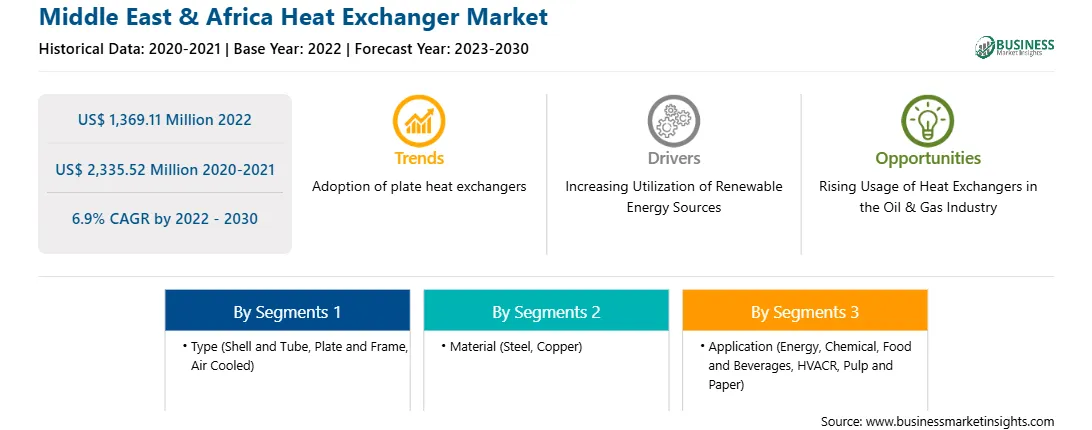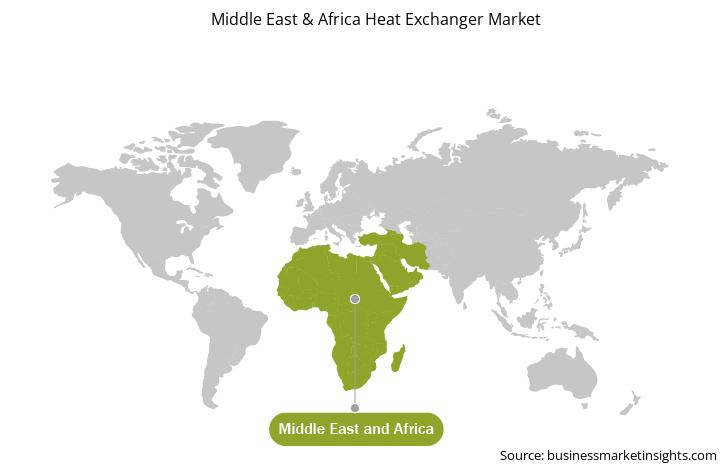The Middle East & Africa heat exchanger market was valued at US$ 1,369.11 million in 2022 and is expected to reach US$ 2,335.52 million by 2030; it is estimated to grow at a CAGR of 6.9% from 2022 to 2030.
Introduction of Heat Exchange Subscription Model Fuel the Middle East & Africa Heat Exchanger Market
Companies are constantly seeking solutions that help them save costs, enabling them to use the saved amount for their other business operations. Many companies are taking innovative initiatives to provide solutions that are environment-friendly due to rising concerns about climate change. In January 2023, Kelvion Holding GmbH announced its plan to provide heat exchangers under the "Heat Exchange as a Service" pay-per-use business model as an innovative solution that can help its customers reduce capital expenditure. The company's main focus was to address the rising concern over CO2 emissions and introduce the subscription model to provide heat exchangers. The introduction of the product-service system helps small and medium-sized enterprises avail themselves of these services, from installation to maintenance, in a cost-effective manner and optimize their cash flow management. Heat exchanger is used in several end user industries such as automotive, chemical, and food & beverages for various applications. Thus, the subscription model will help the SMEs operating in these industries to adopt heat exchangers and encourage emerging players to use this cost-effective solution, which is expected to bolster the heat exchanger market during the forecast period years.
Middle East & Africa Heat Exchanger Market Overview
The Middle East & Africa (MEA) heat exchanger market is segmented into South Africa, Saudi Arabia, the UAE, Turkey, and the Rest of MEA. Infrastructure development in the countries across the MEA, including commercial infrastructure, has been rising over the years. Although these countries are focusing extensively on tourism, the commercial infrastructure plays a major role in the respective country's economy. The region witnessed high investment in commercial construction, such as supermarkets, specialty stores, and malls. These factors are increasing the demand for heat exchangers for the infrastructure HVAC system to maintain the systems efficiency, thereby contributing to the development of the heat exchanger market in the Middle East & Africa.
Middle East & Africa Heat Exchanger Market Revenue and Forecast to 2030 (US$ Million)
Strategic insights for the Middle East & Africa Heat Exchanger provides data-driven analysis of the industry landscape, including current trends, key players, and regional nuances. These insights offer actionable recommendations, enabling readers to differentiate themselves from competitors by identifying untapped segments or developing unique value propositions. Leveraging data analytics, these insights help industry players anticipate the market shifts, whether investors, manufacturers, or other stakeholders. A future-oriented perspective is essential, helping stakeholders anticipate market shifts and position themselves for long-term success in this dynamic region. Ultimately, effective strategic insights empower readers to make informed decisions that drive profitability and achieve their business objectives within the market.

| Report Attribute | Details |
|---|---|
| Market size in 2022 | US$ 1,369.11 Million |
| Market Size by 2030 | US$ 2,335.52 Million |
| Global CAGR (2022 - 2030) | 6.9% |
| Historical Data | 2020-2021 |
| Forecast period | 2023-2030 |
| Segments Covered |
By Type
|
| Regions and Countries Covered | Middle East and Africa
|
| Market leaders and key company profiles |
The geographic scope of the Middle East & Africa Heat Exchanger refers to the specific areas in which a business operates and competes. Understanding local distinctions, such as diverse consumer preferences (e.g., demand for specific plug types or battery backup durations), varying economic conditions, and regulatory environments, is crucial for tailoring strategies to specific markets. Businesses can expand their reach by identifying underserved areas or adapting their offerings to meet local demands. A clear market focus allows for more effective resource allocation, targeted marketing campaigns, and better positioning against local competitors, ultimately driving growth in those targeted areas.

1. Alfa Laval AB
2. API Heat Transfer Inc
3. Danfoss AS
4. Johnson Controls International Plc
5. Larsen & Toubro Ltd
6. Xylem Inc
The Middle East & Africa Heat Exchanger Market is valued at US$ 1,369.11 Million in 2022, it is projected to reach US$ 2,335.52 Million by 2030.
As per our report Middle East & Africa Heat Exchanger Market, the market size is valued at US$ 1,369.11 Million in 2022, projecting it to reach US$ 2,335.52 Million by 2030. This translates to a CAGR of approximately 6.9% during the forecast period.
The Middle East & Africa Heat Exchanger Market report typically cover these key segments-
The historic period, base year, and forecast period can vary slightly depending on the specific market research report. However, for the Middle East & Africa Heat Exchanger Market report:
The Middle East & Africa Heat Exchanger Market is populated by several key players, each contributing to its growth and innovation. Some of the major players include:
The Middle East & Africa Heat Exchanger Market report is valuable for diverse stakeholders, including:
Essentially, anyone involved in or considering involvement in the Middle East & Africa Heat Exchanger Market value chain can benefit from the information contained in a comprehensive market report.